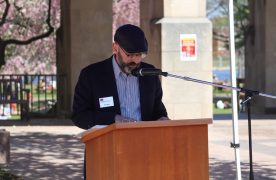Though the money is there, the distribution of federal funding for HIV and AIDS patients in the Boston area needs to be restructured, said a council of experts and those who suffer from the diseases yesterday.
The Boston Eligible Metropolitan Area HIV Service Planning Council met at the John Hancock Conference Center to discuss methods of distributing federal government contracted subsidies for AIDS sufferers in Boston who cannot provide for themselves.
The council, which meets a few times annually, is an independent organization that works with the city to maintain and prioritize the Ryan White Care Act, a national law established in 1990 designed to help support people diagnosed with HIV and AIDS in eligible metropolitan areas.
Under the law, Boston is one of the nation’s most eligible cities for receiving federal HIV/AIDS treatment funds and grants.
At the meeting, council members focused on the proper partition of federal grants to special programs and healthcare coverage.
“We were prepared for the worst,” said Chairman of the Boston EMA Ryan White Planning Council Larry Day.
Day said only through the committee’s “diligence and passion” did it see success in obtaining adequate funding. After the council jumped from four to 14 members in 2007, Day said he is optimistic that next year will bring even more support and cash to the cause in Boston.
“We’re excited for the possibilities for this term,” Day said.
The council focused on the government’s establishment of new limits for fund allocation. Rich Stevens, a council grantee and Director of HIV/AIDS Program of the Boston Public Health AIDS Service, said 75 percent of the Ryan White fund was designated for medical care for AIDS or HIV sufferers within the Boston EMA until recently.
He said the remaining 25 percent was not enough to cover the remaining support services, such as housing, mental health services and transportation.
“To go up to 75 percent [for health services] doesn’t make sense,” Stevens said.
The council was able to change the 75 percent for health services to 55 percent, and the 25 percent for supplemental services to 45 percent this past year, he said.
At each council meeting, members follow a cycle of steps to help them evaluate the needs of those living with AIDS in their EMA, Day said. The council is separated into several committees, which target various council goals.
The Resource and Allocations Committee, for example, gives out grant money and prepares for the next year’s grant, making recommendations for proper distribution of funds each spring.
This is an account occasionally used by the Daily Free Press editors to post archived posts from previous iterations of the site or otherwise for special circumstance publications. See authorship info on the byline at the top of the page.













